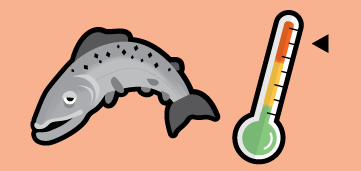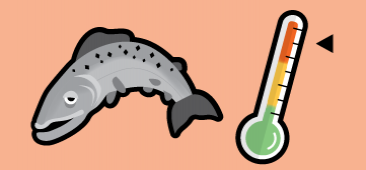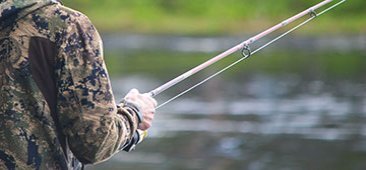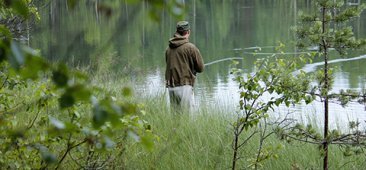Guidelines for responsible fishing
Each and every fisher is obligated to ensure the proper and respectful treatment of the fish they catch. Finnish law prohibits causing wildlife any unnecessary suffering. All fishers must therefore understand, as obligated by law, how to treat all fish they catch, regardless of whether they intend to release them or keep them for food.
Preliminary dressing of food fish
The proper preliminary dressing of fish caught for food has a major impact on the quality, preservability and flavour of fish.
Stunning
Fish should be stunned immediately after removing them from the water by striking it sharply with, for example, a wood club, slightly behind the eyes. The Animal Welfare Decree requires stunning the fish before beginning to dress it.
Bleeding
The most effective way to bleed a fish is to cut the gill artery, which is located inside the throat muscles toward the front of the gills. Bleeding is done immediately after stunning the fish. The draining of blood can be further enhanced by placing the fish in cold water.
Gutting
When gutting a fish, the abdomen is cut open from the base of the throat to the anus. The entrails and gills are then pulled out. Lastly, the fish is rinsed out with cold, clean water.
Cooling and storage
Immediately after gutting, the fish is to be cooled as quickly as possible. The ideal storage temperature is 0 degrees - in order to reach this temperature, the fish should be kept in crushed ice. Higher temperatures shorten the preservability of fish.
Releasing your catch
It is nearly impossible for a fisher to choose which species or size of fish they will hook. Catch and release applies to practically all fishers who observe set catch sizes and otherwise abide by the Fishing Act. Each and every fisher should therefore know the fundamentals of catch and release. In some fishing destinations, fishing rules and regulations may also require the release of fish caught. In addition to this, catch and release fishing competitions are becoming more popular.
Selective fishing includes the release of both undersized and large-sized individuals. Large-sized individuals are invaluable to the fish population because they are typically able to produce more robust offspring than their smaller peers, thus keeping the population strong. In some special fishing destinations, maximum allowable sizes are indeed set for fish. Many recreational fishers also voluntarily release any large-sized fish they catch.
Catch and release when angling
Equipment
- Fishing tackle should always be chosen according to the desired fish. The correct choice of fishing tackle can reduce the need to release fish and also facilitate their release.
- When lure fishing, the number of hooks should be reduced and barbless hooks should be used.
- The landing net should be large enough and made with knotless netting. Landing nets should ideally use a rubber-like netting.
- Basic angler tackle should include sufficiently large and sturdy pliers for removing hooks. Pike fishers should also have pliers capable of cutting hooks. Fishing supply stores carry several different types of hook removers.
Tiring and releasing the fish
- When lure fishing, the fish should be intentionally tired out, but without any unnecessary tearing. An extending tiring out of the fish should be avoided, particularly when the water is warm.
- If possible, the fish should be released in the water. The hook is removed by turning it toward the direction of entry. If desired, a mouth spreader can be used to hold the fish's mouth open. Mouth spreaders are sold at fishing supply stores.
- If the hook cannot be removed with the fish in the water, the fish is to be placed on a flat, wet surface, handled with wet hands and then released as soon as possible after the hook is removed. Fishing supply stores also sell catch and release mats, on which the fish can be handled safely without damaging its scales.
Release
- The fish being released can be supported in the water with two hands until the fish has recovered and is ready to swim away. In running water, the fish's head should be facing upstream.
- The fish does not need to be moved during its recovery - movement only increases its stress.
Catch selection and release when trap fishing
Tackle and fishing destinations
- In trap fishing, the importance of the tackle used and fishing destination are emphasised. Releasing a fish caught in a net alive is usually difficult, but catch selection can be influenced by, for example, choosing a net with the correct mesh size. Indeed, there are mesh size restrictions set for fishers in many water areas. Always check the fishing restrictions in your fishing area before heading out!
- The net mesh size can have an impact on the size of the fish you want to catch, but not the species. Fishers should therefore be familiar with the yearly behaviour patterns of their desired fish and reduce the number of undesired fish caught by carefully choosing their equipment and fishing destinations.
- Using nets with a medium mesh size of 25-49 mm is extremely harmful to predatory fish stocks. A responsible net fisher will always use a mesh size that is a bit too large rather than one that is too small.
- Wire fish traps and fyke nets are the preferred trap fishing equipment, because they make catch selection and release easy, without causing any injury to the fish.
Checking traps
- The less time a fish spends in a trap, the more likely it will be to release it alive. Checking traps as frequently as possible also ensure that the catch quality remains high.
- Water temperature has a major impact on the frequency of trap checks. When net fishing in the winter, fish stay edible for several days, but in the summer, fish caught in a vendace net set at the surface of the water will die and spoil within hours.
Releasing fish from traps
- When releasing fish, avoid any unnecessary handling and, if possible, removing them from the water.
- Fish being released from a trap may need to be supported by hand during their recovery. Once fully recovered, the fish will swim away. The fish does not need to be moved during its recovery - movement only increases its stress.
- According to the Fishing Decree, even dead fish that are below the minimum catch size must be released into the water. In other words, fishers must never have any undersized fish in their catch.
Taking water temperature into account
On hot summer days, water temperature often rises to a level that is too high for fish. The metabolism of cold-blooded fish speeds up in warm weather and they consume more oxygen. Less oxygen is dissolved in warm than in cool water, making the conditions for fish difficult. Many salmonids are in a particularly burdensome situation in which they can withstand higher temperatures less than, for example, zander (Sander lucioperca), northern pike (Esox lucius) and European perch (Perca fluviatilis). Temperatures above 21 °C already make salmonids’ adaptation difficult.
Being caught causes the fish stress. If the fish has to be released back into the water, its recovery from fishing stress and strain is considerably weaker during warm water. It is also possible that the fish will die due to stress and lack of oxygen after release. Typical salmonids to be released include undersized trout (Salmo trutta), protected trout (trout with an adipose fin) and landlocked salmon (Salmo salar m. sebago). Playing, handling and releasing the fish should be carried out as quickly and carefully as possible in warm weather.
Water temperatures are monitored in some of Metsähallitus' fishing destination. You can check the real-time water temperatures in map.sensormonitor.fi.
In hot weather, fish for species other than the salmonids
Different fish species can withstand and tolerate high temperatures in different ways. The fish species least tolerant of heat include many salmonids such as salmon (Salmo salar), vendace (Coregonus albula), arctic char (Salvelinus alpinus), trout and grayling (Thymallus thymallus). By contrast, some fish species fare well even at very high temperatures. These species include roach (Rutilus rutilus), zander (Lucioperca), perch, pike, tench (Tinca tinca) and crucian (Carassius carassius).
Optimal and critical temperatures for some species:
- Grayling: Optimum temperature 4-18 °C, critical temperature 24 °C
- Trout: Optimum temperature 4-19 °C, critical temperature 26 °C
- Rainbow trout (Oncorhynchus mykiss): Optimum temperature 9-17 °C
Responsible fishermen avoid fishing for salmonids (undersized or protected species) that may have to be released in hot weather. For example, fishing for trout in rapids in hot weather should be avoided when water temperature rises well above 20 °C. If you are doubtful about water temperature, the best thing to do is to put the trip off for another time when the weather is cooler or to fish for species that are more resistant to high temperatures or that are taken as catch during fishing in any case.
It should also be noted that in warm water, fish become passive and may stop feeding, and, on top of that, salmonids are typically not very willing to bite a lure. For many reasons, hot summer weather is not an ideal time to fish for salmonids.
Thermometer for fishing waters
 At temperatures higher than 21 °C, salmonids stop feeding, the oxygen content of water decreases and the survival chances of released fish decrease.
At temperatures higher than 21 °C, salmonids stop feeding, the oxygen content of water decreases and the survival chances of released fish decrease.- At 17-21 °C, the feeding activity of salmonids decreases. Fishing should be focused on cool times of the day. Follow the weather forecast for the next few days before purchasing a permit.
- At temperatures lower than 17 °C, salmonids feed actively. Fish can easily be released.
ROD FISHING IN HOT WEATHER AT RAPID FISHING DESTINATIONS MANAGED BY METSÄHALLITUS
During the summer, at Metsähallitus' rapid fishing destinations where fishing mainly focuses on trout, salmon and grayling, developments in water temperature are monitored. When water temperatures reach above 20 °C, Metsähallitus recommends that you avoid fishing for salmonids and, rather, focus on species that are more tolerant to heat and handling. As water temperatures start exceeding 21 °C, Metsähallitus may temporarily suspend the sale of permits for a particular fishing area in order to safeguard natural salmonid stocks. The sale of permits is always suspended for a certain period of time, after which the situation is reassessed.
If the sale of permits is suspended, the sport fisherman may choose from among the following options:
- A permit already purchased for a particular period of time may be transferred to another free period (within the scope of the permit quotas). The transfer can be made within the current fishing season, not, for example, for the following year. No separate fee is charged for the transfer. The transfer must be performed before the validity of the permit begins.
- A purchased permit can be cancelled in its entirety and refunded. In accordance with the procurement and cancellation terms, a processing cost of EUR 13 will be charged for the cancellation. The cancellation must be performed before the validity of the permit begins.
- You can use the permit that you have purchased if you so desire, but this is not recommended. Metsähallitus cannot unilaterally amend or withdraw a fishing permit without the consent of the permit holder.

Heat is deadly to fish
The catch and release of fish in warm water is extremely strenuous, even fatal, for salmonids. Responsible anglers refrain from fishing for salmonids when the water temperature rises above 21° C. On hot summer days, you may fish for species that are more resistant to heat, such as perch, zander, pike, asp and ide.
- At temperatures lower than 17 °C, salmonids feed actively. Fish can easily be released.
- At 17-21 °C, the feeding activity of salmonids decreases. Fishing should be focused on cool times of the day. Follow the weather forecast for the next few days before purchasing a permit.
- At temperatures higher than 21 °C, salmonids stop feeding, the oxygen content of water decreases and the survival chances of released fish decrease.

Properly dispose of your old fishing lines!
A responsible angler always properly disposes of their trash. Pieces of old fishing line and other waste have no place on the shores or in the waters of fishing sites.

Fishing terminology
What do fishing right holder, catch size or general fishing right mean? The Angler's ABC explains these and other key fishing terms.
